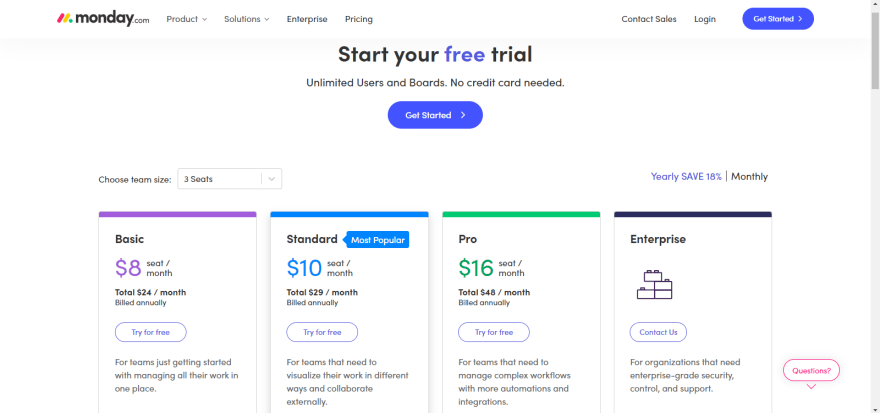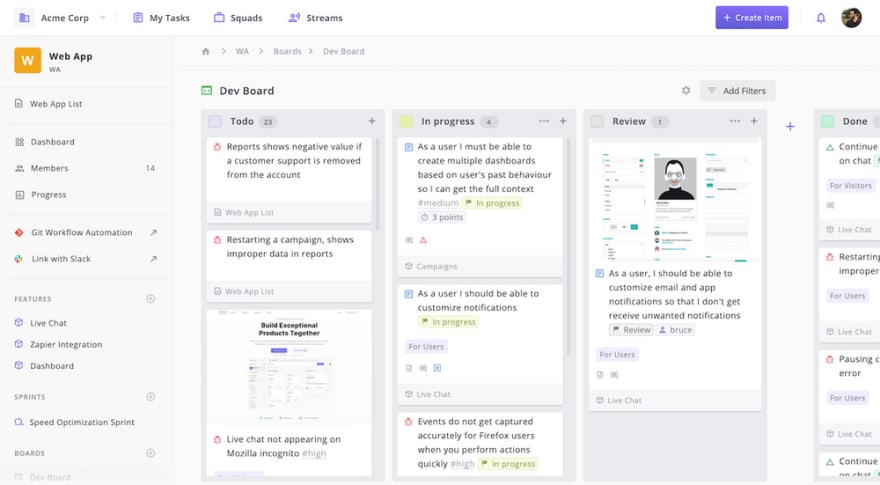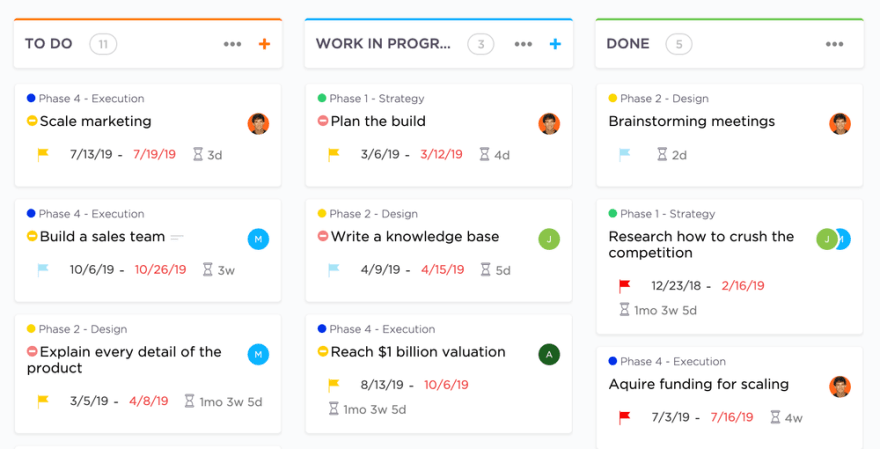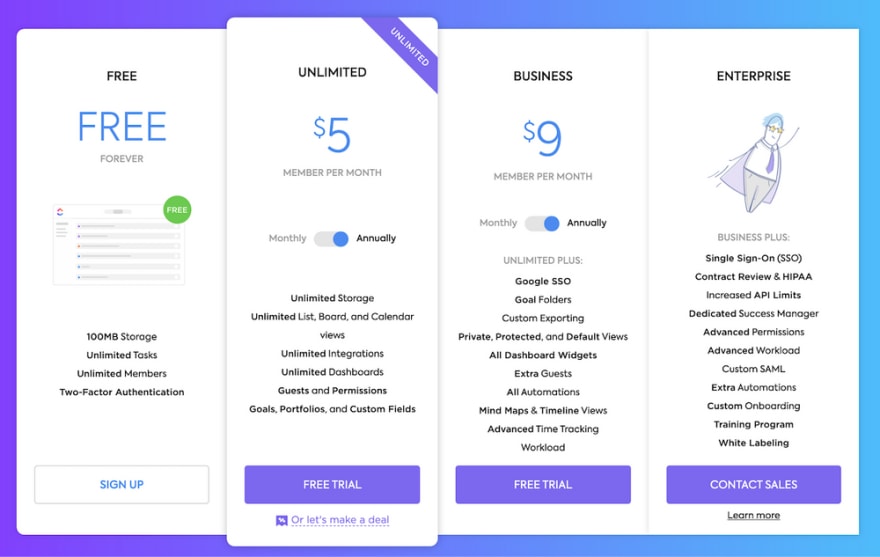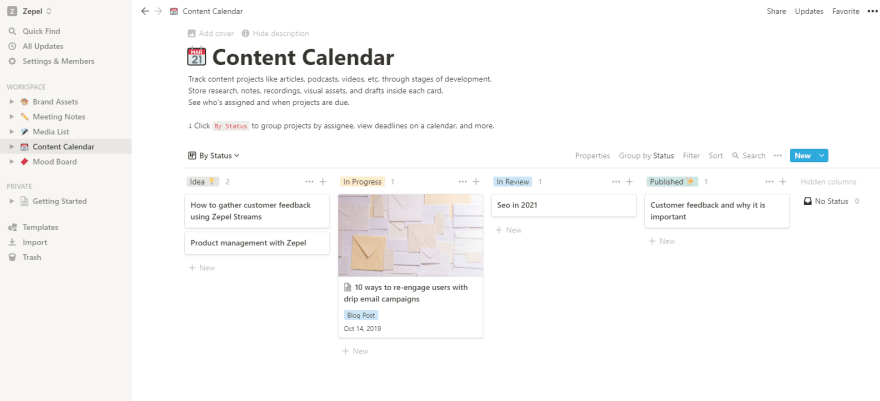Asana Vs Trello Vs Monday: What’s your best bet in 2021?

Ranjali Roy
Posted on February 2, 2021

Asana, Trello, and monday.com are 3 popular software that are battling it out to be your must-have PM software. But who’s going to emerge as the winner?
I have pitted them against each other, compared them in detail based on key aspects a PM application should have, and have given my final verdict.
But before that, let’s have a quick overview of the three apps.
Asana - The project management solution centered around tasks
Asana is a widely-preferred versatile project management platform that was founded in 2008 by former Facebook founder Dustin Moskovitz and former Facebook employee Justin Rosenstein.
Here, everything revolves around projects and tasks. So, for every project you create, you can create tasks and subtasks, prioritize them, allocate them, and manage them. Asana, in a nutshell, is the quintessence of task management.
Asana’s strength, however, is its collaboration capability where it enables you to not only keep all your work items in one place but also your conversations under one roof.
Conversations feature in this app aims to remove the need for team communication apps like Slack, Hipchat, etc.
But when it comes to agile capabilities, other than having a basic kanban board, this software doesn’t support the implementation of other agile frameworks like scrum. This makes it less ideal for software development teams who like getting things done the agile way.
Key capabilities to help accomplish your work
- Task-oriented functionalities like description, assignees, due date, tags, comments, and file attachment
- Rules feature enables automation of routine processes
- Different views such as list, board, timeline, calendar, and workload to track progress
- Portfolios feature to monitor all project initiatives in one place
- Conversations feature keeps all conversations under one roof
- A good deal of integrations with in-demand applications like Slack, Jira Server, Miro, Gmail, etc
What's best in this software
- The Portfolios feature is a great option to keep track of all your initiatives in one place.
- You can automate and streamline your routine processes with Asana’s Rules feature.
- Asana provides version control to help you keep tabs on all the changes made to your software code.
- You can integrate Asana with over 160 third-party apps.
- Asana’s Conversations enables you to keep all your work items and conversations under one roof, removing the need for external apps like Slack, Hipchat, etc.
What's missing in this app to manage your work effortlessly
- Asana lacks agile capabilities to implement other frameworks such as scrum whereas Zepel has Boards, Sprints, and more.
- Asana doesn’t allow a nestled view of all the tasks and subtasks like Zepel does.
- You cannot add multiple assignees to a task.
- Unlike other tools, Asana doesn’t offer the task dependencies feature in its free plan. Asana can get pretty expensive and has a steep learning curve and there are better, cheaper, and easier to onboard alternatives to Asana out there.
Asana pricing
Asana’s plans include a free version that allows you to collaborate with up to 15 members, having a limit on the number of functionalities that can be accessed.
However, you have the option of choosing any one of the following paid plans to get access to all the features: Premium plan costing $10.99/member/month (paid annually) or $13.49/member/month (paid monthly) and **Business plan costing $24.99/member/month (paid annually) or $30.49/member/month (paid monthly).
Contact the sales department for an enterprise plan.
Trello - The kanban tool to collaborate effortlessly
In 2011, Trello was founded by Joel Spolsky and Michael Pryor with a design that mimics your office board with sticky notes.
Trello is a classic kanban board software that represents projects and sticky-note-like cards that represent tasks. A Trello board is divided into columns such as Todo, Doing, and Done to represent statuses of each process, which can be edited to suit your needs. The cards are assigned to appropriate columns and as progress is made, each card is moved from Todo through Doing to Done.
When Atlassian - the maker of Jira - acquired Trello in 2017, companies started comparing Trello vs Jira. Being a simple software with not many functionalities, small squads opted to begin with Trello and later switch to JIRA once their company grew.
However now, organizations needn’t worry about having to make such painful jumps as there are plenty of project management software like Zepel, offering the perfect balance that these apps lack.
Key features to help you manage work
- Board with editable columns that represents a project
- The card is content-rich and represents a task
- Collaboration-focussed aspects like description, assignees, due dates, tags, comments, and file attachments of up to 250MB per file
- A large collection of pre-existing templates for a variety of team-types
- Power-ups available to add on functionalities to boards and cards
- Plenty of third-party integrations that aid in connecting with squad favourites like GitHub, GitLab, Slack, etc
What's best in this kanban solution
- Trello provides the simplicity of organizing work items on a board.
- Visualizing projects via boards enables squads to have a quick view of who’s doing what and how they’re progressing.
- Onboarding squads takes less than 10 minutes due to Trello’s ease of use and simple GUI.
- Collaborate with unlimited users for free with Trello’s free plan
- Trello offers a plethora of power-ups and more than 200 3rd-party integrations with leading apps.
- The mobile app is just as good as the desktop version.
What's missing in this kanban app for organizing tasks
- Trello is no more than a simple Kanban board that can't be used extensively to implement other agile frameworks, and although you can use Trello for scrum, it doesn’t provide functionalities to implement scrum properly as Zepel does.
- It has only a limited set of in-built functionalities that wouldn’t suffice for a software development squad. Despite this, if you pick Trello, you will need to add a whole lot of power-ups and third-party integrations to do basic task handling.
- Trello offers just the board view built-in with the rest of the views available as power-ups only.
- Trello lacks the task dependency functionality that you find in leading apps like Zepel, which makes tracking conflicts difficult.
- Exporting your data isn’t an option in Trello.
- Your functionalities are limited if you opt for a free plan but Zepel doesn’t have feature restrictions in its free plan.
Read about the comparison on Asana vs Trello.
Trello paid plans
Trello offers a free plan to bring onboard unlimited users but with limited functionalities. To access all its functionalities, opt for one of its paid plans: a Business plan starting at $9.99/person/month charged annually or 12.50/person/month charged monthly and an Enterprise plan at $17.50/person/month.
Monday.com - The all-in-one suite to handle all your projects
Monday.com, known formerly as DaPulse, is a visually appealing task management software that’s been around for over a decade, catering to both IT and non-IT companies. So, you can bring onboard and collaborate with different departments to work together in one place.
Monday.com’s colourful, attractive, and intuitive UI makes it fun to work with but extremely complicated to use, especially for newbies. You can find tons of in-built functionalities and third-party integrations that enable you to perform a wide range of activities from bug tracking to CRM.
But this results in a lot of clutter that you don’t find in competitor software like Zepel as some of the attributes can overwhelm and distract you from achieving your goals.
Key features to help fulfill tasks for your business
- Visual boards for task allocation and handling to meet deadlines
- Customizable shareable forms to receive client info
- Dashboard and to-do list to aid in tracking individual progress
- Automations to customize and automate workflows
- Multiple in-built views such as Board, List, Calendar, Gantt (Timeline), Chart, and Workload
- Variety of templates for different kinds of projects
- 15 third-party integrations with widely-used applications like Slack, Google Drive, Dropbox, Zendesk, Zoom, etc
What’s best in this PM suite for managing tasks
- Monday.com provides a wide variety of functionalities from development tracking to CRM that makes multi-department collaboration easy.
- Colourful, attractive, and intuitive UI that makes PM fun.
- Monday.com enables you to assign multiple users to work on a task.
What’s missing in this application
- Monday.com lacks a straightforward GUI as the current one is convoluted, making the learning curve very steep, especially while onboarding new squad members.
- Apart from boards for kanban, monday.com doesn’t support agile capabilities such as Sprints for scrum teams that you can find in Zepel, are absent.
- Unlike most of its competitors including Zepel, Monday’s collaboration-focussed task-related aspects can be confusing to get a hang of as they aren’t present in one place.
- Task dependencies can be added only via a separate column to additionally be kept track of and not in the item card itself as you’ll find in Zepel.
- You can’t find as many third-party apps to integrate as Asana or - Trello but use Zapier to connect with those apps that aren’t available.
- An uncomplicated pricing structure. However, a free plan similar to many other PM apps is missing.
Have a look at the detailed comparison of Trello vs monday.com.
Monday.com pricing scheme
Monday.com does not include a free plan but offers a 14-day free trial. As soon as your trial expires, you must pick one of the paid plans that best meets your requirements. The basic plan starts at $8/seat/month billed annually. The standard plan is at $10/seat/month billed annually. And Pro plan costs $16/seat/month billed annually.
For an enterprise plan, contact the sales department of monday.com.
Difference b/w Asana, Trello, Monday: Which of these project management tools suits your team?
| Asana | Trello | Monday.com | |
|---|---|---|---|
|
Views & Features |
Several in-built views namely list, board, calendar, timeline, and workload. More than sufficient features in the paid plan but lacks agile capabilities other than kanban. |
Only the Kanban Board view is built-in. Basic limited functionalities in both free and paid plans and it lacks agile capabilities. |
Plenty of built-in views such as Kanban Board, Timeline, Calendar, Workload, and List. Has far too many features than needed but lacks agile capabilities like Asana and Trello. The functionalities vary based on pricing. |
|
User Experience & Ease of Use |
Fairly simple but requires a bit of time to get a hang of it. |
Simple UI that’s the easiest of the 3 apps to learn and onboarding takes only a couple of minutes. |
Colourful and fun drag and drop UI but has an extremely steep learning curve. |
| Collaboration |
Can collaborate only 15 users on the free plan. Offers collaboration-focussed functionalities like assignee, due date, comments, etc. Dependencies can be added but it isn’t available in the free plan. |
Collaborate quickly with ease with unlimited users. Offers all the basic traditional collaboration-focussed attributes but lacks task dependencies to collaborate efficiently. |
Cannot collaborate with users for free as there’s no free plan. Offers the usual traditional collaboration-focussed functionalities but they’re not in one place. Dependencies can be added but only as a separate column. |
| Integrations |
160 integrations to 3rd party apps. |
200 integrations and power-ups are available. |
50+ integrations with popular software apps are available. |
| Pricing |
Straightforward pricing with a free plan for up to 15 members with limited functionalities and 3 paid plans - premium, business, and enterprise, that starts at $10.99/person/month billed annually. |
Simple pricing scheme having a free plan for unlimited users but with restrictions on functionalities and 2 paid plans - business class and enterprise, starting at $9.99/user/month billed annually. |
Complex pricing scheme with 4 paid plans - basic, standard, pro, and enterprise, starting at $8/seat/month billed annually. |
| Best for |
IT and Non-IT squads of all sizes, especially the design and marketing squads as Asana ranks high for squad collaboration. |
Small startups and small companies that use only kanban and don’t need powerful project administration capabilities. |
IT and Non-IT companies that require a multitude of functions from bug tracking to CRM but don’t mind the price. |
The final verdict on Trello vs Asana vs Monday: Picking the best project management software
Asana is the right choice for you if you’re looking for a task management tool that takes a task-oriented approach to project administration. You would get a great number of functionalities but you can’t implement agile frameworks other than kanban and you will be paying quite the sum for it.
Meanwhile, Zepel allows you to implement both Scrum and Kanban.
Trello is ideal for your company if you are small, want a PM software that’s a digital version of your office board with sticky notes, and you prefer visualizing your project over powerful project administration functionalities such as agile capabilities.
If visualizing is your priority, you should consider a more powerful Trello alternative.
Pick monday.com if you want a software that is decent at doing everything from task handling to CRM but isn’t the best at anything. Also, if you opt for this app then make sure your squad is prepared for a steep learning curve, spending quite a few dollars, and forgoing the need for agile capabilities that you find in top apps these days.
If none of these project management tools seems ideal, don’t settle for less because several alternatives will not only be easy on your pocket but are more likely to fit your organization’s needs.
Alternative tools to Asana, Trello, and Monday
The pain of sifting through a plethora of project management apps only to find out they don’t meet your needs may lead you to compromise. But don’t adjust now, only to regret it later.
If you like Asana, Trello, and Monday.com but are looking for a better application, here are a few alternatives that are likely to meet your standards.
1. Zepel
Zepel is the perfect application for software development. Zepel’s UI is straightforward all the while being packed with powerful functionalities from managing tasks to customer requests. You can now painlessly onboard squads of any size in no time.
Zepel’s USP is its agile capabilities that enable you to implement not just kanban, but also scrum. And if you wish to combine both these frameworks, you can do that too.
Check out how Zepel compares with other agile PM apps.
Is that the only thing Zepel’s good at? Certainly not.
Zepel is sought-after by many software development squads because it’s development-friendly, unlike most popular apps. And this is owing to Zepel’s deep integration with git and other similar sources. Most dev squads probably hate PM apps for having to manually update their progress all the time.
And perhaps, sometimes, they forget to update their progress because they’re tired of this boring status update routine and would rather focus on doing what they love - building functionalities.
To prevent this from happening, Zepel lets you set up git workflows so that each time a developer makes progress, their status is automatically updated. You can complete your workflow automation by connecting Zepel with your Slack account to receive real-time notifications of status updates.
What’s more? Zepel additionally takes care of bringing in all your customer feedback from various sources like Intercom, Zendesk, Canny, etc., to help you organize them, prioritize them, and build functionalities with context.
Highlights:
- Collaborate with squads of any size
- Easy onboarding due to uncomplicated UI
- Agile capabilities like Sprints, burndown charts, etc that allow implementing Scrum, Kanban, and a combination of both
- Developer-friendly due to deep integration with GitLab, Bitbucket, and GitHub and similar sources
- Workflow automation and real-time notifications via integrations with apps like Slack
- Gathers customer feedback from multiple sources, helps prioritize it, and build customer-focussed functionalities
- Extremely affordable pricing plan!
Pricing plan
Zepel offers a simple pricing plan that does not restrict you on functionalities irrespective of your plan. Your first 5 members are free forever even when you add more than 5 members. The standard plan is priced at $5/member/month when paid annually and $7/member/month when paid monthly.
Check out all the capabilities that Zepel has to offer.
2. Basecamp
Basecamp is a notable competitor in the PM sector to Asana, Trello, and Monday. Being a remote company in the service sector, if views like Kanban or Gantt aren’t your priority, you can opt for this software with confidence.
Basecamp consists of a multitude of functionalities for managing work, including an in-built messaging platform for team collaboration similar to Asana. But some of the attributes shine out like client access and automatic check-in requests for status updates.
Highlights
- Messaging platform like Slack for team communication and collaboration, with a forum-like view
- Automatic check-ins to get frequent status updates
- Client access but with the ability to control what they see
- Hill charts to view and track progress
- Share files and docs with a storage of 500GB (in paid plan)
Payment scheme
Basecamp pricing includes a free 30-day trial to try out all its functionalities. Once the trial is up, you will be charged a flat fee of $99/month for an unlimited number of projects and users.
Have a look at the list of attributes Basecamp offers here.
3. Clickup
Clickup is a software worth mentioning in this segment due to its continuous efforts to be an all-in-one PM suite, although it is far from perfect.
Clickup comes loaded with functionalities that can get a bit overwhelming and distracting for a software development squad. But there are some pretty cool attributes you can find such as its machine learning capabilities that try to predict who you are likely to assign a task to, time estimates, and so on.
Highlights:
- Attractive UI with multiple templates
- Rich attributes and multifarious views to monitor progress
- Machine learning capabilities (beta stage)
- Customization of the app from fields to notifications
- Clickup chats to keep all squad-related conversations in one place
Click here for an in-depth comparison of Clickup vs Trello.
Pricing plan
Clickup’s pricing plan has a free forever plan consisting of unlimited users with unlimited tasks but with limited storage of 100 MB. There are 3 paid plans - unlimited, business, and enterprise, starting at $5/member/month when paid annually and $9/member/month when paid monthly.
Here are all the functionalities that Clickup offers.
4. Notion
Ever since its launch in 2018, Notion has been gaining popularity as a productivity app mainly preferred by marketing squads and other non-IT squads.
Notion, at first glance, may seem nothing more than a note-taking app. But having a proper look at it will show you that it is an all-in-one productivity app that lets you use it as a project management solution, data managing app, and more.
What makes Notion attractive is the app’s simplicity, ease of use, and the flexibility to customize the app as per your wants.
Highlights
- Simple UI that is incredibly easy to use
- Flexible and can be molded any way you want
- Powerful note-taking ability with multiple templates
- Integrations to many trending applications
- Free to use but with feature restrictions
Payment plan
Notion is free to use but the free plan has limited functionalities and allows up to 5 guests. If you want more of them, multiple paid plans range from from $4/member/month to $8/member/month. Check out the pricing here.
View all the functionalities that Notion provides here.
Zepel is the tool tailored for your team: Here’s why
Zepel ticks all your boxes if you’re a software development squad that is looking for a PM app that can:
- Collaborate with cross-functional squads of any size
- Implement both scrum and kanban or a combination of both
- Automate workflow to automatically update dev squad’s progress with its deep integrations
- Make the handoff between product manager and engineers easier
- Bring in customer feedback from multiple sources as requests to build and ship functions with context
- Provide a great affordable pricing plan
Sign up with Zepel today and end your search for the best PM software for your squad, once and for all. You can take the word of 4000+ software development squads for it. :)

Posted on February 2, 2021
Join Our Newsletter. No Spam, Only the good stuff.
Sign up to receive the latest update from our blog.





